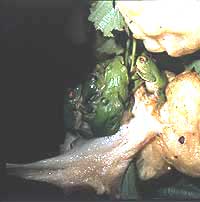
| Pseudonym reading | Oomu Namamori Akira and its events |
|---|---|
| Specified type | Country designation |
| Type | Natural monuments and animals |
| Designated date | December 8, 1972 |
| Specified details | |
| quantity | |
| location | Hachimantai City Parquet |
| owner | Country |
| Holding group | |
| Management organization | |
| home page |
Overview
Oyurinuma is located on the north side of the Kita-no-Mata River, on the side of the old road from Higashi-Hachimantai (Yashidai) to the Fuji-seven hot spring.
This area is about 1,100 m above sea level, and it is a mixed forest of dake kamba, Aomorito domatsu, alder tree, willow and so on, and there is a big upland swamp.
The area is about 1.7 ha and wetlands are developed around the swamp.
The frog has a suction cup at the fingertip and climbs the tree well.
The body color is a so-called protective color and is not uniform such as bluish green, dark brown or greenish brown spots.
The spawning season is from mid-June to the beginning of July.
By this time, male and female frogs climb up to the branches overhanging the water surface of ponds and swamps and lay eggs on twigs and leaves.
When the female produces a mucous egg mass, the male who climbs on the back of the female stirs the egg mass in the hind limb with the female.
The egg mass will eventually expand with air and look like hydrangea flowers from a distance.
As the sun goes on, the white egg mass turns yellow-brown, and the hatched tadpoles fall into the water surface below.
With such a paradox, the tree frog breeds in a swamp from the beech zone to the subalpine zone.
There are several breeding grounds in the prefecture, but the ones with the most egg production are the Oyurinuma and Shiraishi in Shizukuishicho.
